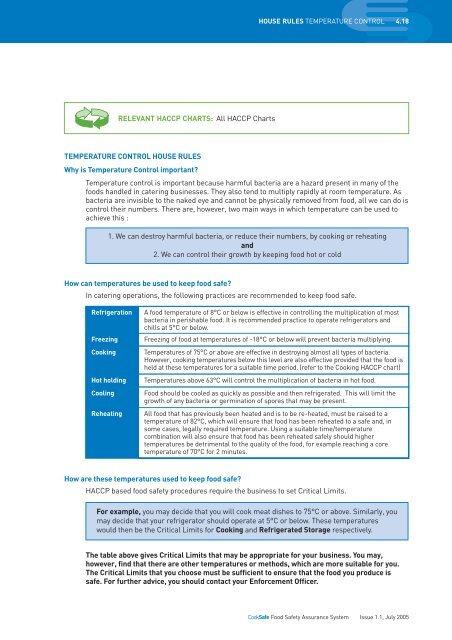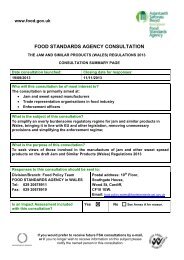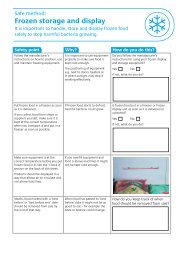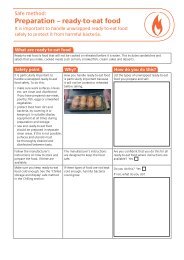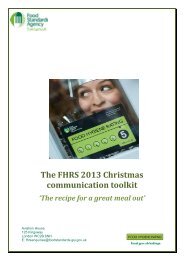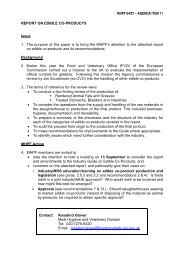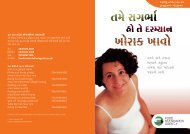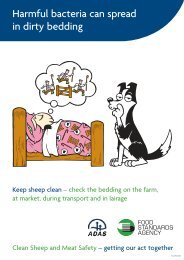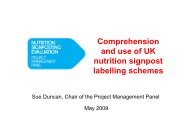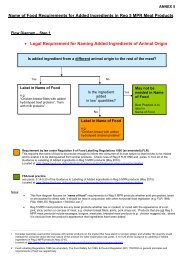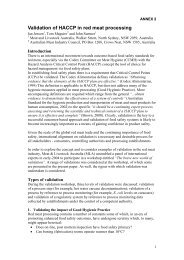4. HOUSE RULES TEMPERATURE CONTROL
4. HOUSE RULES TEMPERATURE CONTROL
4. HOUSE RULES TEMPERATURE CONTROL
You also want an ePaper? Increase the reach of your titles
YUMPU automatically turns print PDFs into web optimized ePapers that Google loves.
RELEVANT HACCP CHARTS: All HACCP Charts<br />
<strong>HOUSE</strong> <strong>RULES</strong> <strong>TEMPERATURE</strong> <strong>CONTROL</strong> <strong>4.</strong>18<br />
<strong>TEMPERATURE</strong> <strong>CONTROL</strong> <strong>HOUSE</strong> <strong>RULES</strong><br />
Why is Temperature Control important?<br />
Temperature control is important because harmful bacteria are a hazard present in many of the<br />
foods handled in catering businesses. They also tend to multiply rapidly at room temperature. As<br />
bacteria are invisible to the naked eye and cannot be physically removed from food, all we can do is<br />
control their numbers. There are, however, two main ways in which temperature can be used to<br />
achieve this :<br />
1. We can destroy harmful bacteria, or reduce their numbers, by cooking or reheating<br />
and<br />
2. We can control their growth by keeping food hot or cold<br />
How can temperatures be used to keep food safe?<br />
In catering operations, the following practices are recommended to keep food safe.<br />
Refrigeration A food temperature of 8°C or below is effective in controlling the multiplication of most<br />
bacteria in perishable food. It is recommended practice to operate refrigerators and<br />
chills at 5°C or below.<br />
Freezing Freezing of food at temperatures of -18°C or below will prevent bacteria multiplying.<br />
Cooking Temperatures of 75°C or above are effective in destroying almost all types of bacteria.<br />
However, cooking temperatures below this level are also effective provided that the food is<br />
held at these temperatures for a suitable time period. (refer to the Cooking HACCP chart)<br />
Hot holding Temperatures above 63°C will control the multiplication of bacteria in hot food.<br />
Cooling Food should be cooled as quickly as possible and then refrigerated. This will limit the<br />
growth of any bacteria or germination of spores that may be present.<br />
Reheating All food that has previously been heated and is to be re-heated, must be raised to a<br />
temperature of 82°C, which will ensure that food has been reheated to a safe and, in<br />
some cases, legally required temperature. Using a suitable time/temperature<br />
combination will also ensure that food has been reheated safely should higher<br />
temperatures be detrimental to the quality of the food, for example reaching a core<br />
temperature of 70°C for 2 minutes.<br />
How are these temperatures used to keep food safe?<br />
HACCP based food safety procedures require the business to set Critical Limits.<br />
For example, you may decide that you will cook meat dishes to 75°C or above. Similarly, you<br />
may decide that your refrigerator should operate at 5°C or below. These temperatures<br />
would then be the Critical Limits for Cooking and Refrigerated Storage respectively.<br />
The table above gives Critical Limits that may be appropriate for your business. You may,<br />
however, find that there are other temperatures or methods, which are more suitable for you.<br />
The Critical Limits that you choose must be sufficient to ensure that the food you produce is<br />
safe. For further advice, you should contact your Enforcement Officer.<br />
CookSafe Food Safety Assurance System Issue 1.1, July 2005


